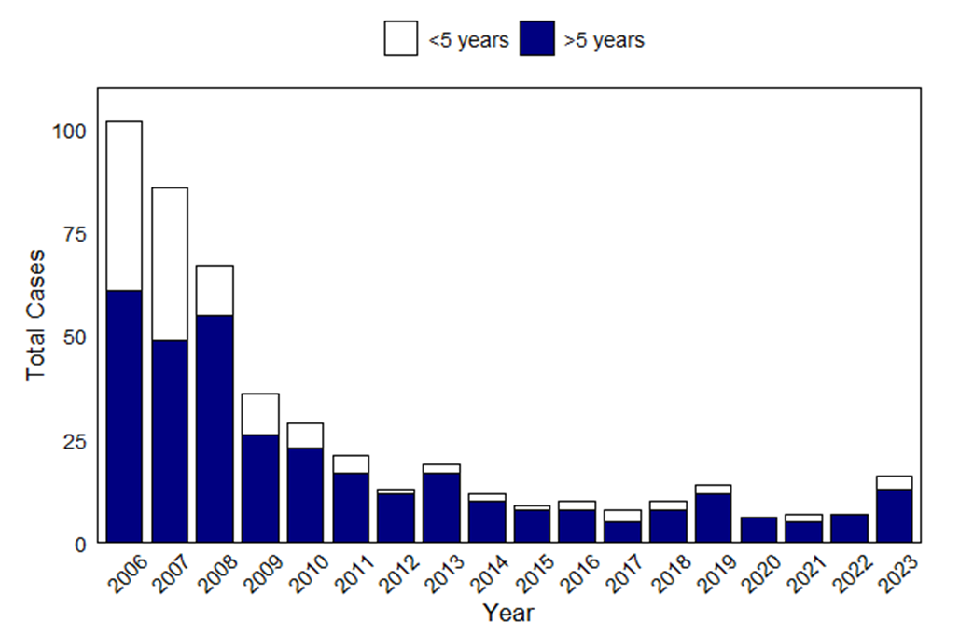Laboratory reports of Haemophilus influenzae by age group and serotype, England: annual 2023 (and 2022)
Updated 26 June 2025
Applies to England
During 2023 (January to December inclusive), there were 706 confirmed cases of invasive Haemophilus influenzae (Hi). This was a 17.1% increase compared to 2022 (706 in 2023 compared with 603 in 2022) (Table 1).
Restrictions due to the COVID-19 pandemic were associated with reductions in a number of infections, including invasive Haemophilus influenzae disease, during 2020 (1), with cases remaining low during 2021 and since rebounding in 2022.
In 2023, 3.1% of isolates (22 of 706) were not serotyped, compared to 11.6% (70 of 603) not typed in 2022. Of those serotyped, most isolates were non-encapsulated Haemophilus influenzae (ncHi) (83.9%; 574 of 684), which compares with 80.5% (429 of 533) in 2022.
In 2023, there were 16 cases of invasive H. influenzae serotype b (Hib) disease, accounting for 2.3% (16 of 684) compared to 1.3% (7 of 533) of cases with serotyped isolates in 2022. Of these, 13 (81.2%) were diagnosed in adults (age 15+ years), whilst 3 (18.8%) were in children under the age of 5 years. There were 94 (13.7%) cases of invasive disease due to other encapsulated H. influenzae types in 2023 including: 59 (8.6%) serotype f, 18 (2.6%) serotype a and 17 (2.5%) serotype e.
The overall incidence of invasive H. influenzae disease was 1.24 per 100,000 population in 2023, being 2.45 per 100,000 population in children under 5 years of age compared to 1.17 per 100,00 in those aged 5 years and older.
There were no deaths attributed to invasive Hib disease in 2022 or 2023. The most recent deaths attributed to invasive Hib disease in an adult was in 2015 and in 2011 in a child. As reported previously (2), cases of invasive Hib disease have declined since the introduction of the Hib conjugate vaccine in 1992 and have remained at low levels since the introduction of the 12-month booster in 2006 (Figure 1). In 2023, invasive Hib disease continued to be well-controlled across all age groups.
Table 1. Number of Haemophilus influenzae cases by serotype and age group, England, 2022 and 2023.
(‘Not typed’ refers to samples that have not been received at the reference laboratory for typing.)
| Type | <1 year: 2022 | <1 year: 2023 | 1 to 4 years: 2022 | 1 to 4 years: 2023 | 5 to 14 years: 2022 | 5 to 14 years: 2023 | 15+ years: 2022 | 15+ years: 2023 | Total 2022 | Total 2023 |
|---|---|---|---|---|---|---|---|---|---|---|
| b | 0 | 2 | 0 | 1 | 0 | 0 | 7 | 13 | 7 | 16 |
| Non capsulated | 36 | 32 | 21 | 27 | 14 | 18 | 358 | 497 | 429 | 574 |
| a,e,f | 6 | 5 | 5 | 6 | 4 | 2 | 82 | 81 | 97 | 94 |
| Not typed | 8 | 2 | 3 | 0 | 2 | 1 | 57 | 19 | 70 | 22 |
| Total | 50 | 41 | 29 | 34 | 20 | 21 | 504 | 610 | 603 | 706 |
Figure 1. Total cases of Haemophilus influenzae by year, 2006 to 2023

References
1. Brueggemann AB, Jansen van Rensburg MJ, Shaw D, McCarthy ND, Jolley KA, Maiden MCJ and others. Changes in the incidence of invasive disease due to Streptococcus pneumoniae, Haemophilus influenzae, and Neisseria meningitidis during the COVID-19 pandemic in 26 countries and territories in the Invasive Respiratory Infection Surveillance Initiative: a prospective analysis of surveillance data The Lancet Digital Health 2021: volume 3, issue 6
2. Laboratory reports of Haemophilus influenzae by age group and serotype (England and Wales): annual report for 2015. Health Protection Report: volume 10, issue 8
